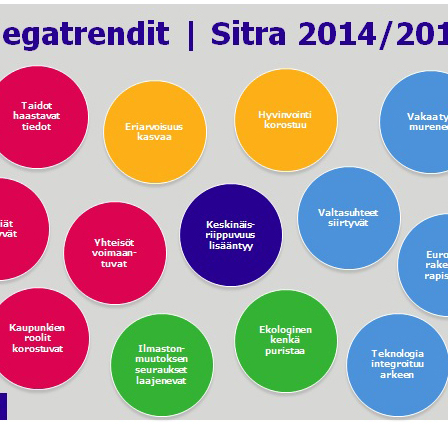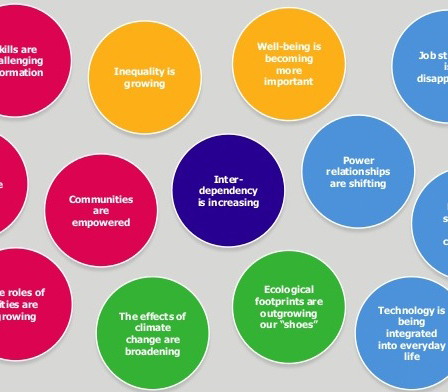This series of articles – Sitra Trends – reviews the trends listed by Sitra during October 2014, from a variety of perspectives. This article is the sixth in the series.
Climate change is undeniable – the scientific world is uncommonly unanimous on this issue. Numerous scenarios and guides have been written on how to mitigate and adapt to climate change. These can help policymakers and corporate leaders to build a sustainable future. Businesses and investors have also woken up to the effects of climate change. The markets have received more solutions and funding than ever before. Climate change is reshaping business activities all over the world.
The climate change negotiations of the 20th session of the Conference of the Parties (COP20) were held in Lima, Peru in mid-December 2014. In Lima, the question of who will fund mitigation measures was identified as a key bottleneck in achieving a universal climate agreement. Developing countries are clearly unwilling to foot the bill for the effects of emissions generated by industrialised countries. The country which is the largest polluter is not necessarily the most obvious paymaster. We need a common vision on how to divide the advantages and disadvantages, and liabilities and benefits, among countries.
The outcome of the Lima negotiations puts the world on track for the conclusion of a new universal climate agreement at the COP21 in Paris in autumn 2015. Although the setting of emission reduction targets was left to individual countries, the commitment of all participants to achieving reductions and their promise of transparency for their own reduction targets by March 2015 was a major achievement.
Limitations and solutions
Climate change has progressed to the stage where it is impacting on the finances of businesses. The issue can be said to have split the business community down the middle: there is the “business as usual” old guard, mainly consisting of heavy industry, and the new “mitigation offers new business opportunities” crew.
The old guard is dragging its feet and sometimes even resisting action to curb climate change and the more stringent regulation that this will entail. Why? Because if new policies for curbing climate change (e.g. ecological tax reforms and effective universal climate agreements) become a reality, some vested interests will have a great deal to lose. For example, the oil industry, other particularly energy-intensive industries and various associated interest groups would be on the losing side. These prospective losers have been able to use their positions to delay the required shift towards new politics.
The old guard’s influence is based on its economic clout and size. For example, the worldwide oil industry is estimated to spend roughly 600 billion US dollars a year on searching for new oil deposits. By comparison, according to the IPCC Fifth Assessment Report (Intergovernmental Panel on Climate Change), less than 400 billion US dollars are spent globally each year on mitigating or adapting to climate change.
But the new players are different. Businesses of this type would gain from the transition. Clear regulations, even if more stringent, would provide these players with greater certainty and a more stable business environment. It would also open up a huge number of new opportunities for businesses engaged in combating climate change.
Sustainable solutions are profitable
Saving the world is not the primary motivation of businesses that provide solutions for curbing climate change – it may be a secondary motive, but profit is the number one aim. The successful businesses of the future have already begun their transformation towards a low-carbon approach. Forerunners are already building new business like this.
Among executives, emission reduction requires a radical change in mindset. Only a few firms have adopted a business strategy aimed at ambitious emission reduction and low-carbon targets, but a growing number are incorporating sustainability criteria into their strategies. So we are headed in the right direction.
Good examples abound. In its European operations, the American listed company Interface Inc. has achieved excellent results in its search for alternatives to the use of non-renewables. Some 95% of the energy consumed by the company’s European operations and plants is renewable, the factories generate zero waste and CO2 emissions have been slashed by 90% compared to 1996. And yes, with a turnover of one billion US dollars, this company is making a profit, while providing employment for more than 3,000 people worldwide.
What about Finland? Let’s take an example: Eniram’s sensors and software can help shipping companies and lines to achieve major savings in fuel and operating costs, by enabling them to monitor vessel speed and performance, weather conditions and other factors. Based on this, they can adjust their vessel trim, speed and RPM in real time. As for so many groundbreaking inventions, this too is about a new combination of existing elements. In turn, KONE harnesses the braking energy of its lifts and uses this to reduce customers’ energy consumption. Outotec is cutting the waste and emissions generated by its customers by using technologies that make efficient use of raw materials, enhance material recycling and reduce water and energy consumption.
So there is no shortage of role models. But more is needed to make sustainable business the norm.
Everyone follows the money
Developments in the financial markets are also being shaped by climate change. For example, cleantech solutions are already attracting market-based demand and funding. An ever-growing number of investors are also giving thought to factoring carbon risks into their portfolio analyses, or are already doing so, in addition to financial, political and other risks. However, to understand how to manage carbon risks investors need more information. The UK-based Carbon Tracker Initiative has already developed some tools for doing this.
Carbon risks are not just about climate change; financial risks are also involved – for example, many oil-related projects are based on the gamble that oil prices will remain high. At present, the price of crude oil per barrel is at the same level as in late 2008; then, the downward trend continued almost to the level of the early 2000s. And since fluctuations in oil prices partly depend on the political decisions taken by oil-producing countries, the Ukraine crisis and the Russian rouble’s downward spiral are creating new uncertainty in terms of price developments.
Although many players have already begun to diversify their investment portfolios by moving away from fossil fuels, such a huge transformation in the investment world will not happen overnight. The UN’s new Green Climate Fund, which is intended to steer funding towards accelerating the climate change mitigation measures taken by low-income countries, adds yet another dimension to this transformation. By Tuesday 9 December 2014, pledges worth over eight billion euros had been collected for the fund. The most recent ones came from unexpected sources: in addition to Belgium’s 50 million euros, Australia, which has so far been reluctant to participate in climate change measures, has pledged over 130 million euros.
Will there be sufficient credit?
In the financial world, climate change is affecting national credit ratings as well as corporate investments and fund investment criteria. In practice, developing countries have no way of reacting rapidly to threats of this kind to their credit rating. According to the ND-GAIN (Notre Dame global adaptation index), coastal states such as Cambodia, Vietnam and Bangladesh are the most vulnerable.
While Finland has managed to retain its high credit rating despite the economic downturn, the effects of climate change will require national adaptation measures. These will be related to issues such as the use of natural resources, to the diversity of the natural environment, to the built environment and to human health. According to a study published in November, four out of every five European countries have already woken up to the need to adapt to climate change and have placed this on their political agendas. This is due to the occurrence of extreme weather events in particular. In fact, the costs of climate change in terms of its effect on human health were also raised at the Lima negotiations.
Towards a transformation to a low-carbon economy
According to the New Climate Economy report “Better Growth – Better Climate”, drawn up by the world’s leading economists, the creation of lasting economic growth need not conflict with mitigating climate change. All that is needed is a pathway towards a low-carbon economy. In addition to the business sector, cities are playing a major role in building sustainable well-being and growth. Cities around the world are already competing vigorously for corporate investment and are attracted to anything “clean or green”. Among European countries, Denmark, and its capital city Copenhagen in particular, have been outstanding in this respect and in various sustainability benchmarking studies.
Climate change may be the key threat of our time, but we have not yet responded with effective economic incentives for reducing CO2 emissions. Environmental experts and many economists agree that simply putting a price on carbon emissions would give us a “big bazooka” to use against climate change. That is why the Climate Leadership Council, founded by Sitra and leading Finnish firms, has challenged all Nordic businesses to support the UN initiative to put a price on carbon.
What next?
In the future, perhaps solar panels will be made from wood, steaks will be grown in laboratories and the ownership of goods will seem like a quaint habit of the past. Trends may change the world, but so too do forerunners. And when the motivation is there, change can happen very quickly. I await with interest to see what solutions Finnish businesses and cities opt for in the battle against climate change.
Read more:
Radio Australia: Cambodia’s economy most at risk from climate change – Report
Bloomberg News: Climate change to hit sovereign creditworthiness
Phys.org: Future solar cells may be made of wood
The Guardian: Solar has won – Even if coal were free to burn power stations couldn’t compete
USA Today: Report – Climate change a huge economic risk
The Nassau Guardian: Climate change a threat to sovereign rating
The New York Times: Pentagon Signals Security Risks of Climate Change
Grist: We don’t, and can’t, know how much it will cost to tackle climate change
World Climate Ltd: World Climate Summit Announces Major Initiatives During COP20
Wikipedia: List of largest companies by revenue
IPCC: Climate change 2014 Synthesis Report
The New York Times: U.N. Panel Issues Its Starkest Warning Yet on Global Warming
The New York Times: Panel’s Latest Warming Warning Misses Global Slumber Party on Energy Research
Industrial News Services: Laivojen rikkipäästöjä koskeva EU-direktiivi tarjoaa mahdollisuuksia polttoainetta säästäville innovaatioille
Helsingin sanomat: Astu vaikka sisään luontokeskus Haltiaan
Maa- ja metsätalousministeriö: Kansallinen ilmastonmuutoksen sopeutumissuunnitelma






Recommended